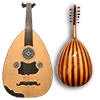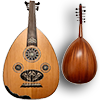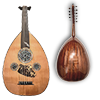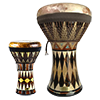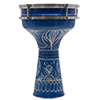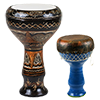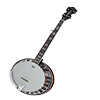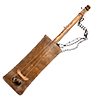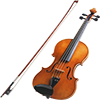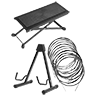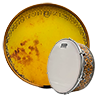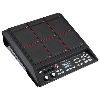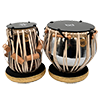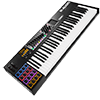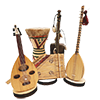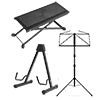All about Darbuka
The Darbuka instrument has a history dating back to the Common Era in Egypt and comes in various shapes and sizes. It is also very common in Anatolia , Mesopotamia , Arab countries and North Africa. The darbuka is often played in Turkish folk music accompanied by other instruments or solo and has also become an important instrument in Turkish classical music in recent times. This cheerful instrument has different names in various regions such as "dümbek", "dümbelek", "tömbek" but its original name " dümbelek" is actually an Arabic name which originally means "to hit".
There are two sounds in the darbuka, called düm and tek: the first sound provides the basis for the rhythm and is obtained by striking the middle of the instrument, the second sound is mainly used for decoration and improvisation. The darbuka is also a kind of percussion instrument used in entertainments such as weddings.
The Darbuka instrument is a goblet-shaped percussion instrument. It narrows in the middle and widens at the other end. The head of the instrument is wider than the other end. The traditional darbouka instrument has sheepskin , goatskin and fish skin for good sound quality, although contemporary instruments have a chemical skin called "glass skin". This prevents the darbuka from bursting or tearing so that it has a longer lifespan. The body of traditional darbukas was made of forged copper, but nowadays the casting technique is used for better sound. Mother of pearl coating can be used for ornamentation of some types.
The darbuka instrument is played in a seated position or with standing straps. It is located under the player's arm with the head of the instrument pointed towards the knees. It can also be played standing up to allow the musician to dance or walk around while playing. The musician can play it simply by using his hands. Although it has different styles and rhythms, it is quite easy to play. Thanks to its playful sound, it is widely used at weddings or for entertainment purposes.
Turkish Darbuka
The body of the Turkish darbuka is made of iron or aluminum , and a synthetic skin is used for the head of the instrument. Several screws are located on the head, around the skin for adjustment. It is usually played with snaps of the fingers or by tapping with the fingertips. Although it varies in certain types, the general measurements are 22 cm in length and 29 cm in diameter. The traditional Turkish darbuka is made of copper and is either held under the arm or rested on the leg. Both hands are used to produce over 50 different sounds on the edge and head of the drum.
Egyptian darbuka
The Egyptian style, is also known as Tabla and is very popular. Different from the Turkish style darbuka, the Egyptian darbuka has rounded edges and the adjustment screws are not exposed. The body can be engraved or adorned with mother-of-pearl. While Egypt is considered the paradise of the Darboukas, its neighbor the Maghreb (Tunisia, Algeria and Morocco), Tunisia in particular boasts of its smaller, clay and goatskin folk versions. This musical instrument is widely used for belly dancers.
Darbouka d'argile/clay
As its name suggests, the body of this instrument is made of clay . Unlike the other two, instead of using synthetic skin, goatskin, sheepskin, and fish skin are stretched over the head. Clay and animal skin give the instrument a more natural sound. It is also called solo darbuka since it is mostly played solo. It is heavier than other types of darboukas due to its material and is usually played on the knees. The clay darbuka form was first used in Arab countries, but with the musical interactions, it also started gaining popularity among Turkish musicians since 1980s. The family of terracotta darbukas can be observed under three main categories named "solo", "sumbati" and "dehollo" from smallest size to largest.
If you want to learn this instrument, master your craft, or expand your percussion family, the first place to start looking is our wide range of finely finished darbuka picks.
A few tips for choosing the right darbouka
- Learn what your instrument is!
Without knowing what your desires are, you cannot choose the right instrument. Even if you are familiar with the instrument, look for more details. For example, the darbuka has different types depending on the region and culture. You need to know the details of these features.
- Characteristics of your objective and your instrument!
Determine your goal of playing darbuka . After that, you can more clearly differentiate the types from each other. Of course, you should also list the types of darbuka with their characteristics. While the Turkish darbuka is mainly used with the snapping method thanks to its design with edges, the Arabic darbuka is suitable for rapid finger rolling. So, even though they belong to the same basic instrument family, as you can see here, there are small differences to make it easier for players to choose the work according to their goals.
- Know the material!
Knowing the materials is another important tip for choosing the right darbuka. Some of them are genuine goatskin or fish skin coverings and some of them are chemical glass skin. Maybe you can't know exactly at a glance, but if you know about darbuka skin , it can help you choose the right one.




